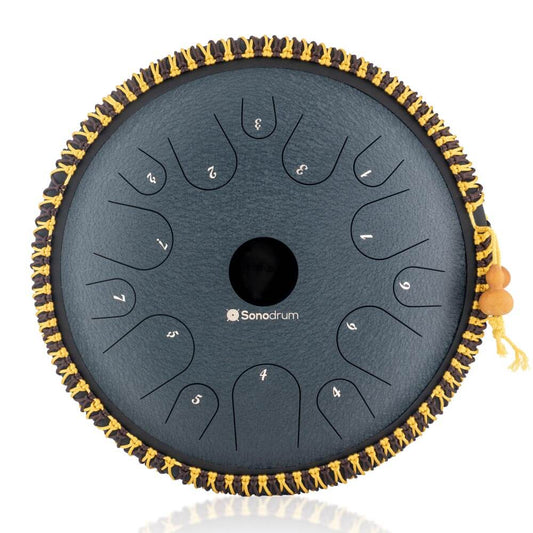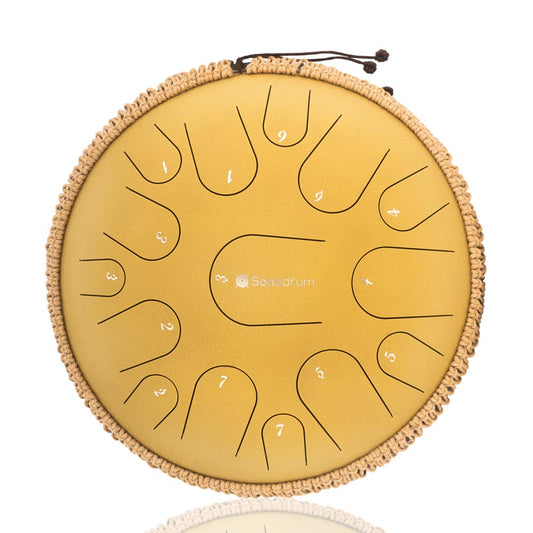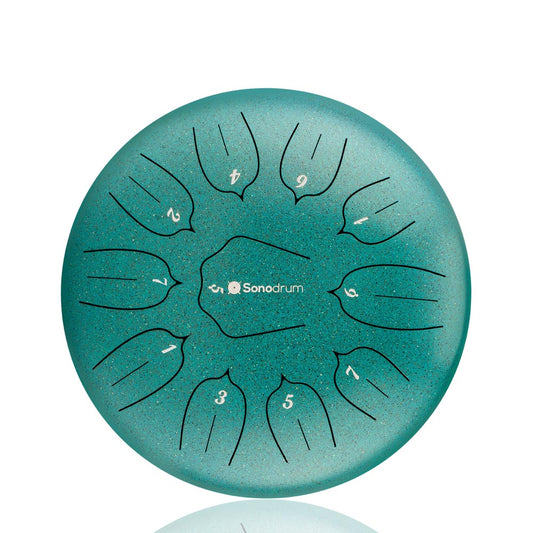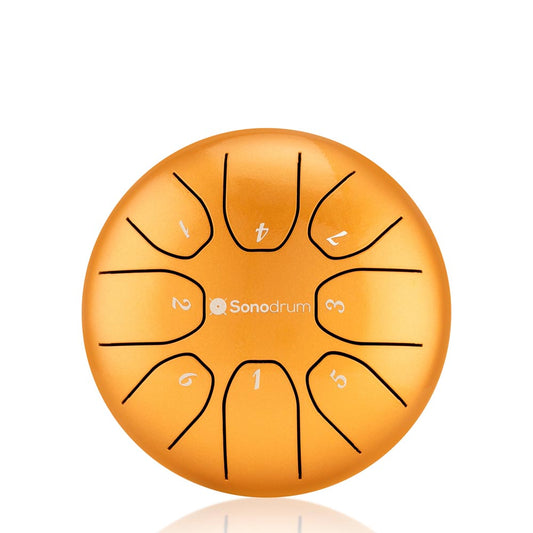Tongue drums for kids offer an exciting way to engage children in music education while promoting mindfulness through play. These unique children’s percussion instruments are not just fun; they also play a vital role in child development. Research shows that interacting with musical instruments like tongue drums enhances cognitive abilities and emotional intelligence in young learners. By integrating these drums into everyday activities, children can experience a balance between creativity, relaxation, and focus, making them an adaptable tool for homes and schools alike.
Key Takeaways
- Tongue drums are perfect for introducing music to children.
- They foster mindfulness through enjoyable play.
- Engaging with tongue drums enhances cognitive skills.
- These instruments promote emotional intelligence in kids.
- Tongue drums cultivate creativity in a relaxed environment.
- They can easily be incorporated into educational settings.
What are Tongue Drums?
Tongue drums are unique percussion instruments that engage both children and adults alike. These instruments stand out due to their captivating sounds and user-friendly design. Understanding the definition of tongue drums provides insight into why they are perfect for beginners and young musicians. Often resembling a bowl with tongues cut out, each tongue produces a different pitch when struck, showcasing various tongue drum features that appeal to novice players.
Overview of Tongue Drums
The structure of tongue drums allows for versatile musical expression. Each drum features a series of tuned tongues that create harmonious sounds. This design makes them perfect for exploring rhythm and melody in a playful manner. Tongue drums can be played with mallets or even hands, which emphasizes their accessibility. By familiarizing with the definition of tongue drums, one can appreciate their role in music education for kids.
Materials and Design
Various materials for tongue drums are used, impacting their tonal quality and durability. Common materials include stainless steel for its resilience and acoustic properties, as well as wood and aluminum for different sound textures. The designs of the drums can range from simple to elaborate, often finished in vibrant colors that attract children's interest. Understanding the materials and design is crucial when selecting the right tongue drum, ensuring a well-rounded musical experience.
Benefits of Music Education for Kids
Music education offers a myriad of advantages, significantly contributing to the development of children. The integration of music into learning provides opportunities to enhance cognitive skills in children while fostering emotional growth. Engaging with music cultivates not only intellectual abilities but also nurtures the emotional landscape, crucial for healthy development.
Enhancing Cognitive Skills
Through structured music programs, children experience remarkable growth in their cognitive skills in children. Research suggests that children involved in music tend to excel in areas such as language acquisition, mathematics, and memory improvement. For instance, music education can lead to heightened IQ levels, improved focus, and better academic performance. These enhanced cognitive abilities create a robust foundation for lifelong learning.
Developing Emotional Intelligence
Participating in music education plays a vital role in cultivating emotional intelligence through music. Children explore their feelings creatively, allowing for self-expression and emotional articulation. This engagement fosters crucial social skills, empathy, and resilience. Music serves as a bridge for children to connect with others and navigate their emotions, resulting in well-rounded individuals ready to face life's challenges.
Tongue Drums for Kids: Introducing Music & Mindfulness Through Play
Tongue drums offer a unique blend of creativity and calm that can greatly benefit children. Not only do they foster creativity in music, but they also serve as an excellent tool for relaxation and focus. Through play, kids can explore sounds and rhythms, leading to spontaneous musical expressions.
Fostering Creativity
Encouraging children to express themselves musically opens up a world of possibilities. The design of tongue drums allows for intuitive playing, where each hit on the surface produces delightful sounds. This natural interaction promotes creativity in music and inspires kids to develop their improvisational skills while exploring various sound combinations.
Promoting Relaxation and Focus
The soothing tones of tongue drums create a peaceful environment, ideal for mindfulness music practice. Children can engage in deep breathing exercises while playing, enhancing their emotional well-being. Regular use can lead to effective relaxation techniques, helping kids to center their thoughts and concentrate better. The rhythmic patterns guide them into a serene state, making relaxation with tongue drums not just enjoyable but beneficial for their overall mental health.
| Aspect | Fostering Creativity | Promoting Relaxation |
|---|---|---|
| Type of Engagement | Spontaneous musical exploration | Mindful breathing and rhythmic playing |
| Emotional Impact | Encourages self-expression | Enhances calmness and focus |
| Skill Development | Improvisation and creativity in music | Concentration and mindfulness practices |
How to Choose the Right Tongue Drum for Your Child
Choosing a tongue drum for your child involves several important factors. One of the primary considerations is the size of tongue drums, especially for younger children who may struggle with larger instruments. A lighter and smaller drum will be easier for them to handle, encouraging a more enjoyable and engaging experience. Additionally, sound quality plays a crucial role in maintaining a child's interest in music. Well-tuned instruments that produce harmonious melodies can significantly enhance their overall playing experience.
Size and Weight Considerations
When selecting a tongue drum, the size and weight are paramount. Instruments designed for children often come in compact sizes that allow for easy playability. Smaller drums can be more manageable, promoting independence in learning. Weighing the drum is also essential; finding a lightweight option guarantees that your child can explore music without frustration. Pay close attention to the dimension specifications provided by manufacturers such as Meinl and Pearl, as they offer a variety tailored to young musicians.
Sound Quality and Tuning
Another critical aspect of choosing a tongue drum is evaluating the sound quality for kids. A well-tuned drum produces clear, rich tones that captivate young minds. Look for drums with precise tuning scales to ensure the instrument resonates beautifully. Brands like Luvay and Nino offer high-quality options that are specifically tuned for children’s enjoyment. Testing different drums can help you identify which sound most appeals to your child, thus fostering a lasting love for music.

Getting Started with Tongue Drums
For those embarking on the journey of learning tongue drums, understanding some foundational techniques is crucial. Engaging children with beginner tongue drum techniques can lay a great foundation for their musical experience. Proper holding of the drum and the correct use of mallets are essential first steps for effective playing.
Basic Techniques for Beginners
Beginner tongue drum techniques include:
- Holding the drum securely with both hands.
- Using mallets that are suited to the drum’s material.
- Experimenting with different striking positions to create varied sounds.
Children can easily incorporate learning tongue drums into their routine by tapping along to their favorite songs. This not only makes the experience enjoyable but reinforces rhythm and timing skills.
Fun Activities to Try
Engaging activities for kids can boost creativity while enhancing their musical skills. Here are some ideas:
- Collaborative group play sessions where children create music together.
- Using the drum to tell stories, promoting imagination and narrative skills.
- Organizing rhythm games that challenge children to keep time with the music.
These activities help children feel more connected to music while encouraging joyful learning experiences. With the right beginner tongue drum techniques and fun activities, little ones will develop a lasting love for music.
Integrating Mindfulness Through Music
Integrating mindfulness through music, particularly with tongue drums, offers a unique approach to help children develop emotional awareness and regulation. Mindfulness music practices can transform play into a soothing experience that nurtures both creativity and focus. Engaging in meditation with tongue drums encourages children to connect with their feelings while fostering a sense of peace and tranquility.
Mindful Meditation with Tongue Drums
Using tongue drums in mindful meditation provides children with an opportunity to explore sound and breathe deeply. By focusing on the rhythmic tones, they can enhance their awareness and relaxation, promoting inner calm. This immersion in sound serves as a wonderful introduction to mindfulness, helping little ones understand their emotions and responses to various situations.
Building a Mindful Routine
Establishing daily mindfulness routines that include tongue drum practice can significantly impact a child's emotional well-being. Devoting just a few minutes each day to playing the drum or engaging in guided meditation can alleviate stress and anxiety. Over time, these simple practices empower children with effective tools for emotional regulation, fostering a more composed and mindful approach to life.
Incorporating Tongue Drums into Playtime
Incorporating tongue drums into playtime creates a vibrant space for social play with tongue drums, enhancing children's interactions. Engaging in group activities for kids centered around music promotes shared music experiences, benefiting both social skills and creativity.
Encouraging Social Interaction
Playing together with tongue drums allows children to express themselves individually while learning how to collaborate. This encourages a sense of belonging and teamwork, as they experiment with different rhythms and sounds. In a group setting, kids develop vital communication skills as they share their unique musical interpretations. This interaction deepens friendships and fosters mutual appreciation among peers.
Ideas for Group Activities
There are numerous ways to introduce tongue drums into group dynamics:
- Drum Circles: Gather children in a circle where everyone takes turns playing, creating a seamless blend of sounds.
- Rhythm Challenges: Set up a fun competition where children mimic rhythms demonstrated by their peers.
- Collaborative Compositions: Encourage kids to work together to compose a simple song, highlighting their individual contributions.
- Improvisation Sessions: Allow children to freely explore sounds, leading to spontaneous rhythms and melodies.
Conclusion
In summary, tongue drums provide a joyful and engaging way for children to interact with music while simultaneously encouraging mindfulness. The various benefits of tongue drums extend beyond mere entertainment; they play a vital role in developing essential skills and emotional intelligence, making them a powerful educational tool. Parents and educators alike will find that these instruments create enriching childhood experiences through creativity and exploration.
The integration of music and mindfulness for kids facilitates a unique learning environment where children can express themselves and relax. As they familiarize themselves with the soothing sounds of tongue drums, they not only gain musical knowledge but also enhance cognitive abilities, nurture emotional growth, and improve concentration. This multifaceted approach truly enriches their overall development.
Ultimately, tongue drums stand out as an effective means to foster personal growth and joyful learning in children. By incorporating such enriching activities into playtime, families can create precious moments that contribute positively to every child's growth journey. Embracing the benefits of tongue drums can lead to lifelong passion and appreciation for music.
FAQ
What are tongue drums and how do they work?
Tongue drums are unique percussion instruments made typically from materials like steel, wood, or aluminum. They feature a bowl-shaped resonator with cut tongues that produce different notes when struck. Children can easily play them using mallets, making music accessible for everyone.
Why are tongue drums beneficial for children's development?
Playing tongue drums enhances cognitive skills such as memory retention and language development while also fostering emotional intelligence. Research shows that musical engagement can lead to better academic performance and creative expression, allowing children to explore their feelings through sound.
How can I choose the right tongue drum for my child?
When selecting a tongue drum, consider the size and weight for comfortable handling. Additionally, assess the sound quality and tuning; well-tuned instruments can improve the playing experience and spark ongoing interest in music.
Can tongue drumming help with mindfulness?
Yes! Integrating tongue drumming into mindful meditation can promote relaxation and emotional awareness. By focusing on deep breathing and the calming sounds of the drum, children can learn valuable tools for managing stress and anxiety.
What activities can children do with tongue drums?
Children can engage in various fun activities with tongue drums, such as tapping along to their favorite songs, creating their own rhythms, or participating in group play sessions. These activities encourage teamwork and collaboration, enhancing social interaction and musical skills.
How do I start my child with tongue drumming?
Start with simple techniques like holding the drum correctly and using the right mallets for striking. Encourage them to experiment with their sounds and rhythms, fostering a playful and engaging environment that enhances their musical journey.




